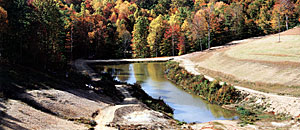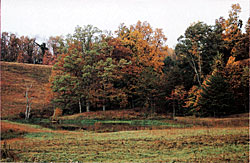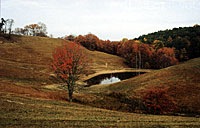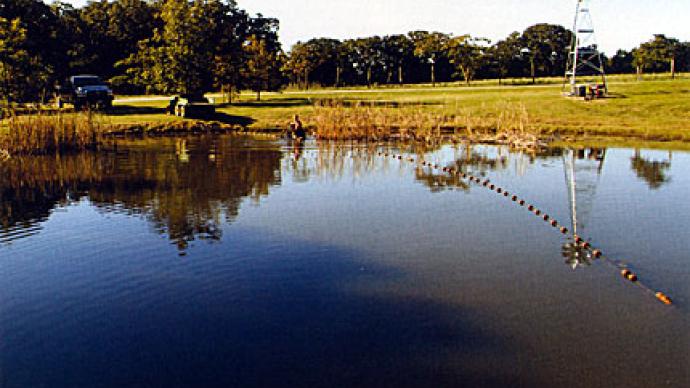
Despite their tiny size, sparkling diamonds are considered among the world's most valuable objects. The same can be said for those sparkling water bodies which dot the landscape all over North America, small ponds. Commonly disregarded by many folks, small ponds can be transformed into magnificent fisheries with the right strategy and management.
No pond is too small to be a productive fishery, provided pond owners understand limitations as size, productivity and depth. Everything is relatively proportional, especially when managing fish quantities.
Regional advantages, such as stocking fish common to a particular region (pike and smallmouth up North) and utilizing super long Growing seasons (Deep South), are localized benefits which need to be emphasized in pond management plans. Selecting the right forage also helps a pond function at full potential.
Naturally, we usually want what we don't have. We want musky and pike in the South, Giant largemouth in the North ... our desires are insatiable. With remarkable strides made within the field of pond management, what was improbable yesterday may be feasible today.
With clear objectives and solid management strategy, small ponds can give the thrill of non-regional fisheries. At the very least, a small pond representation can determine if specialized management goals can be attained without wasting oodles of time and money on an improbable mega-pond set up.
If managed properly, small ponds can generate results just like a mega-pond. It is cool to transform an unproductive pool of water into a dynamic fishery, perhaps the new shining star of your property.
The No Brainer
I love a pond chock full of fish. Throw a nightcrawler in and something's gonna eat it!
The "no brainer" pond is a mixture of species (no exotics please) of assorted sizes whose only management strategy is to load the impoundment with tons of fish. Quantity over quality has a strange drawing power simply because a kid can catch a fish on almost every cast. Just be careful not to overload a pond's carrying capacity (maximum number of fish it can sustain). Disaster will result from too many fish in too small a water body.
My favorite example comes from a grandfather who maintained a beautiful 10-acre pond strictly for trophy bass; very successfully I might add! Problem was, his grandkids couldn't catch much in the trophy pond and from the kid's perspective, fishing granddad's pond wasn't much fun under such a confining regime.
I suggested grandfather use leftover dirt from his original pond to create a "catch all" pond to restock small bass and countless bluegill culled from the trophy pond according to his management plan.
The tiny half-acre pond quickly became a fish-catching factory for kids who weren't concerned about size, just action. Granddad attained hero status for making a "kid" pond... the most popular fishing spot in the entire county ... the site of at least one community fishing derby each year. Talk about maximum return for minimal effort!
Small bass, bluegills, sunfish and even catfish can provide non-stop action for kids and a refresher for adults who just want some line pulling action. Additionally, the "catch all" pond can become a perfect outlet for surplus fish from other management ponds.
Trophy Bass

Think a small lake is a mandatory requirement for growing trophy bass? Well, think again!
Small ponds can grow trophy bass like the big boys, but smaller waters are limited to producing fewer numbers. Even if you only grow one double-digit bass in your small pond, it's still a ten pounder!
Small ponds have the benefit of being easier to keep in check (balance the number of sportfish-bass and forage-bluegill) than lakes. With less acreage to manage, highly accessible water to fish and the ability to make corrections in an aggressive manner, management strategies in small ponds can generate results quickly. Just don't make the mistake many pond owners make by trying to grow too many lunkers at one time. Be happy with a few.
Trophy bass growth can be accelerated through supplemental feeding of forage fish, but be careful that supplemental feed doesn't accumulate on the pond bottom and generate nutrient loading. Such adverse side effects can lower dissolved oxygen and cause late summer fish kills in small ponds, although aeration and pond flushing can guard against this.
Growing trophy bass usually boils down to forage and genetics. Adding rations of fathead minnows is okay, but larger forage such as shad or golden shiners generates faster growth in adult bass. Tilapia have also become a forage phenomenon for trophy bass in locations where they can survive long enough to reproduce heartily. Utilizing tilapia in small pond situations can yield substantial dividends.
Yes, seven to ten pound lunker bass can come from small ponds, even ponds less than an acre, but pond owners must realize there might be less than five trophy bass in such ponds at any given time. Additionally, these lunker bass might be super tough to catch since they virtually rule the pond.
Managing a small pond for trophy bass requires serious discipline and significant harvest of small bass and panfish. But imagine an eight pound bass hanging on your wall (or framed picture of said fish, or fiberglass replica - when did PB get so politically correct?). Oh, the pride of growing an eight pounder from a dinky one-acre pond when your neighbor down the road can't produce even a single bass of that stature in his grandiose 20-acre lake?
With small ponds, feed and cull, feed and cull. Monitor and tweak.
Smallmouth

Smallmouth bass are awesome sportfish. Anglers travel far and wide to float fish for them in scenic rivers, but pond owners seldom give them a second thought.
Traditional thinking indicates smallmouth bass don't do well in ponds, particularly down South, but as my grandfather might say, "Hogwash!"
While smallmouth are certainly more common up north and in cooler waters of the Midwest, these prized sportfish range deep into the South and survive quite nicely in specially managed ponds; "specially managed" being the key phrase.
Across most of the Heartland and northern U.S., smallmouth reproduce in ponds with gravelly substrate. Added gravel seems to be a quick fix for ponds lacking in such substrate. Smallmouth reproduction in southern ponds tends to be inhibited, but supplemental stocking can overcome this hindrance nicely.
Surprisingly, smallmouth are not a good species for a mixed pond set up that might include panfish like bluegill or sunfish. As aggressive as smallmouth are, one would think they would control panfish populations very well, but that does not appear to be the case.
A better forage option for pond smallmouths is a straight prey source of golden shiners or fathead minnows. Remember, you're only buying enough forage to feed a small pond, so providing supplemental forage is a much more realistic option for small ponds than large ones.
Smallmouth also don't compete well with largemouth bass. If you're looking to establish a bronzeback pond, don't include any other bass species. In fact, for your best chance at establishing smallmouth in a small pond, the only gamefish I recommend including is smallmouth.
Predator Pond
Like 'em with teeth and plenty of muscle? Well, don't rule out small ponds if you want to establish a predator pond.
Even though much is still to be discovered about managing predators in small waters, it appears large predators such as musky and pike are viable management options for small, cool water ponds. While results remain varied, some pond managers are growing amazingly large predators in relatively small ponds.
When considering musky or pike, please realize these critters eat lots of forage, so in a 1- to 2-acre pond there could only be a few adult sized predators, maybe fewer than ten. Such small numbers can create a problem not generating enough timely return for pond owners. Pond owners may not even see their prized pond dwellers for years, especially when you embrace the fickle nature of a muskellunge.
Although large musky or pike can eat just about any fish, forage remains the ultimate problem. Small bass and bluegill are perhaps the easiest forage for pond owners to grow, but members of the Esox family prefer soft rayed forage such as suckers, trout or even creek chubs.
In parts of the country where spring fed ponds are common, trout make excellent forage for musky or pike. The point of emphasis is for pond owners to utilize whatever resources are available near their location. Since suckers and creek chubs are preferred food sources for musky, my favorite example of a predator impoundment comes from a pond owner who transformed an old beaver pond into a one acre farm pond.
Primarily filled with creek chubs, the pond owner searched for a manageable solution which would create a sport fishery from an existing forage base of chubs. I suggested musky, and after stocking two 30-inch male musky into the pond, the pond owner eagerly waited for some indication of his management strategy.
It wasn't until two years after initially stocking muskies he caught a 38 incher from the pond, twice in fact, during the same month. The following year he landed a 42 incher from the pond. Male musky don't get much larger than 40 inches, so these fish had likely attained maximum length. Note that stocking fish of the same sex helps prevent overpopulation of top predators in small ponds. Wonder how large female muskies could have grown in his small pond?
Catfish
A hearty eating fish as well as one fun to catch, catfish are synonymous with pond fishing across the country.
Channel cat are the best members of the catfish family for ponds, and they can be purchased from just about any commercial fish dealer. Channel catfish are ideal for small ponds, whether they stand as the pond's solitary sportfish or stocked with a mix of bluegill and bass.
If catfish remain the pond's sole gamefish, a steady ration of fatheads or other forage will enhance growth. Shad are not necessarily a good choice for channel catfish as shad are too quick for catfish to effectively capture. Furthermore, once shad grow into adult size, they can create problematic situations in a pond managed for catfish.
Channel cat reproduction can be impaired in pond settings, but this can be easily overcome by adding a bit of suitable habitat. Channel catfish use natural caverns or hollowed out logs in streams or lakes to carry out their "private matters." Pond managers successfully mimic such structures by sinking old culverts or large diameter PVC pipe (seal off one end) in the pond. Remember to sink structures in shallower water rather than the deepest comer of the pond for maximum response.
Odd balls
Ponds full of trout are quite common in some parts of the country, although a source of cold water or an underground spring is necessary. The same frigid water which impairs bass growth in ponds can be used as a reviving source of water to harbor trout.
Given the right water temperature, ponds can be managed to produce either trophy trout or larger quantities of smaller fish. Many trout ponds are fed a protein-based feed while others rely on rations of fathead minnows or natural insects and depending on your set up, either can be effective. I have seen a number of spectacular trout ponds less than a half acre in size.
Walleye are desirable in impounded waters, but generally struggle in small ponds. Water temperature is a limiting factor. While it's not impossible to maintain pond walleye through supplemental stockings, marble eyes are probably more trouble than they're worth in a small pond set up. It's best to avoid them in small waters.
Given up on the dream of managing your own pond because you don't own (and probably never will) a large enough piece of property to construct a small lake? Don't worry, because if you own or have access to any type of small impoundment, your dream can still come true. With a solid management scheme and some efficient management, you can create a successful, thriving fishery... even in a tiny pond.
Reprinted with permission from Pond Boss Magazine



